|
|
|
Sort Order |
|
|
|
Items / Page
|
|
|
|
|
|
|
| Srl | Item |
| 1 |
ID:
157823
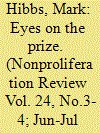

|
|
|
|
|
| Summary/Abstract |
The Nuclear Suppliers Group (NSG) has been beset with its relationship with India ever since New Delhi and Washington in 2005 announced that they would strike up a bilateral partnership requiring that the NSG lift longstanding restrictions aimed at blunting India’s nuclear development. India’s history of hostility to the very mission of the NSG has prompted questions and even suspicion about India’s reasons for wanting to join the arrangement. These concerns continue to affect NSG members’ views about the terms under which India might become a participant; to date India has not been admitted into the group. While India has not openly articulated an elaborate official catalog of its reasons, Indian participants and observers have provided several partial explanations for India’s strong desire for NSG membership. Their statements suggest that a number of specific Indian interests concerning India’s nuclear-energy program would be advanced by NSG participation, but also that India’s ultima ratio is its quest for greater international political status. A historical approach to the case also permits the conclusion that India applied for NSG membership following an evolution in New Delhi’s perceptions of its security threats as well as of the strategic significance of its nuclear-energy program.
|
|
|
|
|
|
|
|
|
|
|
|
|
|
|
|
| 2 |
ID:
157822
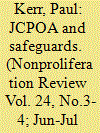

|
|
|
|
|
| Summary/Abstract |
Although the nuclear safeguards established in the 2015 Joint Comprehensive Plan of Action (JCPOA) are explicitly confined to application in Iran, some experts and policy makers have considered whether these supplementary measures could be applied to other states of proliferation concern. While the JCPOA has provided some useful additions to the International Atomic Energy Agency (IAEA) safeguards toolkit, its legacy for the broader IAEA safeguards mission is unclear. To better assess this potential legacy, this article considers the JCPOA in the context of the evolution of safeguards, particularly the developments following the 1991 Gulf War and subsequent changes to safeguards implementation in Iraq. The article then describes the JCPOA’s safeguards in Iran and the potential to apply similar provisions elsewhere.
|
|
|
|
|
|
|
|
|
|
|
|
|
|
|
|
| 3 |
ID:
157820
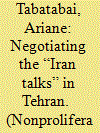

|
|
|
|
|
| Summary/Abstract |
When Iran and the world powers resumed negotiations over Tehran’s controversial nuclear program after a seven-year lull, Iran’s hardline President Mahmoud Ahmadinejad was approaching the end of his second and last term. During that time, little progress was made. After the election of the moderate Hassan Rouhani to the presidency, the talks resumed decisively. Rouhani and his team were in an ideal position to strike a deal, as they were afforded cross-party support supplying them with political will and political capital. To succeed, they had to pursue several goals, including sanctions relief and reintegrating their country into the international community, while ensuring that the nuclear program remained viable within the limits they had to respect. They also had to balance several audiences in Iran and the broader international scene. They operated within the “red lines” developed to reassure various factions within the regime and populace and formalized by Supreme Leader Ayatollah Ali Khamenei. These priorities and limitations shaped the form, substance, and language of the resulting document, the Joint Comprehensive Plan of Action completed and signed on July 14, 2015, in Vienna.
|
|
|
|
|
|
|
|
|
|
|
|
|
|
|
|
| 4 |
ID:
157821
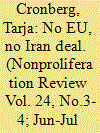

|
|
|
|
|
| Summary/Abstract |
The Iran deal is a European success story of “effective multilateralism.” An initiative by three European states, initiated in response to the US-led military action in Iraq, ultimately demonstrated that proliferation risks can be addressed by diplomacy. Over a decade's time, the European Union (EU) framed the negotiations over Iran's nuclear program in a way that enabled two hostile parties—the United States and Iran—to meet in talks leading to a successful understanding. Two years after its implementation, the deal seems to be working. However, despite Iranian compliance, the deal now faces an uncertain future. The Donald J. Trump administration's Iran policy remains unclear, though there are indications to expect diverging views between the United States and the European Union, further challenging a transatlantic link that had already faced challenges during the negotiations. This article re-examines the history of the negotiations through the lens of the strategic choice the EU faces in its foreign and security policy: steering between effective multilateralism and transatlantic relations.
|
|
|
|
|
|
|
|
|
|
|
|
|
|
|
|
| 5 |
ID:
157826
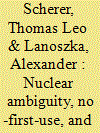

|
|
|
|
|
| Summary/Abstract |
The United States has long embraced calculated ambiguity over the conditions under which it might use nuclear weapons against adversaries, a trend that President Donald J. Trump has continued. This ambiguity could unsettle some observers, especially those who believe that the United States should declare a no-first-use (NFU) policy such that it would not be the first state to introduce nuclear weapons in either a crisis or an armed conflict. NFU advocates identify three potential pathways whereby a more ambiguous posture can lead to increased danger: downward spiral, accidental war, and use-it-or-lose-it. For evidence, they invoke Saddam Hussein’s risk-accepting decision to pre-delegate chemical-weapons use following US nuclear threats in the 1991 Gulf War. In analyzing the reasoning and evidence of these arguments, we argue that the alleged benefits of NFU may be overstated, at least for crisis stability in asymmetric crises, defined by one side’s overwhelming conventional military superiority. Each of the three foregoing pathways is logically inconsistent and the empirical case is misinterpreted. Nuclear ambiguity may not be so dangerous as NFU advocates claim.
|
|
|
|
|
|
|
|
|
|
|
|
|
|
|
|
| 6 |
ID:
157827
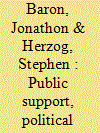

|
|
|
|
|
| Summary/Abstract |
The year 2016 marked twenty years since the Comprehensive Nuclear-Test-Ban Treaty (CTBT) opened for signature; the twenty-fifth anniversary of the US nuclear-testing moratorium occurred the following year. The international political climate, nuclear-explosion-monitoring capabilities, and US stockpile stewardship have all changed drastically since the US Senate voted against CTBT ratification in 1999, and they continue to evolve. Yet the most recent public-opinion survey on the test ban, showing 84 percent approval across the United States, dates to 2012. Do Americans still emphatically support the CTBT? To answer this question, we worked with the research firm YouGov to design and implement a new scientific survey assessing the current state of national opinion toward the test ban. Analyzing the survey results shows that, although US public support for the test ban remains strong, it has probably weakened since 2012. While political party identification is the best predictor of treaty support or opposition, a majority of Democrats, Republicans, and independents support ratification. However, many Americans remain undecided on whether the Senate should provide its “advice and consent” to ratification.
|
|
|
|
|
|
|
|
|
|
|
|
|
|
|
|
| 7 |
ID:
157825
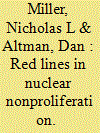

|
|
|
|
|
| Summary/Abstract |
States that seek to prevent nuclear proliferation through threats of force or sanctions often set “red lines,” which set limits on nuclear capabilities beyond which a proliferator must risk triggering a punitive response. Yet despite a wide range of possible red lines that states could choose—for example, constructing a nuclear weapon (weaponization), enriching uranium, or conducting a nuclear test—the academic literature is nearly silent on the tradeoffs inherent in selecting one of these red lines over another. Specifically, what are the vulnerabilities in each red line that proliferators can exploit to advance their nuclear program while limiting the punitive response? To address this question, this article introduces a theory of red lines and how they are challenged. We apply this theory to red lines in nuclear nonproliferation and offer historical evidence to support it.
|
|
|
|
|
|
|
|
|
|
|
|
|
|
|
|
| 8 |
ID:
157824
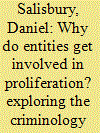

|
|
|
|
|
| Summary/Abstract |
This article seeks to provide an original approach to weapons of mass destruction (WMD)-related illicit trade by drawing on criminology and focusing on the transactional level. Specifically, the article discusses the “rational-choice” model as a way to understand an entity’s involvement in illicit trade, and considers also the limitations of this approach, as well as the role that opportunity plays in an actor’s decision to engage in illicit trade. The article draws the conclusion that the prospects of deterring illicit trade using export controls and related criminal sanctions are limited. Beyond the clear limitations of the rational-choice model, the prospects of deterring illicit WMD trade are limited by the low levels of certainty in export-control enforcement, something that the criminology literature suggests is of greater importance than severity of punishment in deterring crime. Nonproliferation successes are more likely to be found in further efforts to develop tools to address proliferation opportunities, an area that has already seen much work. Efforts to further raise illicit WMD-related trade from the realms of “invisible crime” are necessary, including further conceptual research on illicit trade.
|
|
|
|
|
|
|
|
|
|
|
|
|
|
|
|
|
|
|
|
|